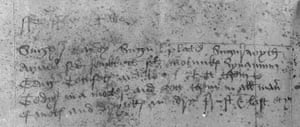have needing a better life asking where is my "Sweet Tea!"Oh god why!
I guess it's best to take in those things that will make life better for you!
Get that what you need and make some candy as it was there all the time for you!
"Initially, the recipe was thought to be for a drink to cure the flux, but the thermal
imaging revealed it to be “dragges” herbal sweets used to refresh the palate and
cure a variety of ills. The ingredients sugar, aniseed, fennel seed, nutmeg,
cinnamon and ginger were luxuries at the time."
~~~~~Recipe found in medieval mystic’s writings was probably for 'dragges'
It is a case that has intrigued historians, psychiatrists and
theologians for the last 80 years, but an academic has found what may be
the oldest known attempt to diagnose Margery Kempe’s erratic religious
behaviour. A recipe for medicinal sweets, written 600 years ago in the
back of the medieval mystic’s memoir, has been deciphered by Dr Laura
Kalas Williams – and the Exeter University-based researcher is convinced
that it reveals an attempt to prescribe a cure for Kempe’s notorious
fits of devotion.Though the recipe, written in the final portfolio of the 1438 manuscript, has long been known to scholars, it had hitherto proved impossible to read. Dr Andrea Clarke, the British Library’s lead curator of medieval and early modern manuscripts, suggested multispectral-imaging technology be used to reveal its secrets. Kalas Williams and two colleagues, Professor Eddie Jones and Professor Daniel Wakelin, were then able to decipher the ingredients and discovered it was a cure for “flux”, defined in the Medieval English Dictionary as “a pathological flowing of blood, excretions or discharges from any part of the body, or dysentery”.
Kalas Williams said she was convinced the recipe was a response to the
mystic’s various bouts of illness as well as her copious crying. “I
don’t think [the recipe] has been written there randomly,” the academic
said. “The book tells us that at one point, she suffered a terrible
episode of flux (probably dysentery) and was given extreme unction,
thinking she was going to die, so the presence of this recipe at the end
seems more than a coincidence.”
A middle-class mother of 14, Kempe lived in Norfolk from about 1373 to
1440. After the birth of her children, she took a vow of chastity, and
for the rest of her life undertook pilgrimages to Jerusalem, Santiago de
Compostela, Italy and Germany.
Kalas Williams admitted her thesis was controversial. Scholars have speculated about the significance of the recipe since the manuscript was rediscovered in 1934. Though medieval books often feature arbitrary jottings because parchment was expensive, no other random notes appear in the manuscript, which was dictated by the mystic between 1436 and 1440, initially to her son. “There are many other annotations in the book, but all of these directly engage with the words on the page, in dialogue with the content,” the academic said. “This makes it improbable that the recipe is a random, thoughtless, annotation.”
The manuscript, which is the only surviving copy of the memoir, thought to be the oldest autobiography by a woman in the English language, has proved controversial since it was rediscovered in the 1930s. Many attempts have been made to explain Kempe’s profuse weeping, collapsing and roaring while under the influence of her visions. As well as epilepsy, bipolar disorder and schizophrenia, it has been posited that the mystic suffered postpartum depression, as her first extreme religious experiences and “demonic torment” followed her first difficult pregnancy.
Kalas Williams dismissed attempts at diagnosis as “anachronistic” and preferred to use Kempe’s memoir to understand the medieval view of women’s bodies and health. “For me, Kempe is a tenacious figure, determined to be heard in a culture where women’s voices were not supposed to be heard, and brave enough to express her emotions publicly and viscerally,” added the scholar, who is writing up her findings for academic publication later this year.
https://www.theguardian.com/books/2017/feb/28/recipe-found-in-medieval-mystics-writings-was-probably-for-drugges-margery-kempe



